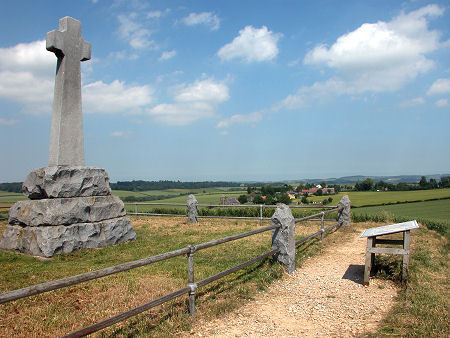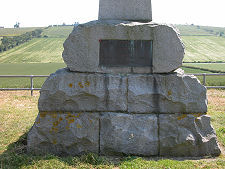 The Site of the Battle of Flodden Field |
James IV lived from 17 March 1473 to 9 September 1513 and was King of Scotland from 11 June 1488 until 9 September 1513. James was born in Stirling Castle. He was just 15 when he acted as the figurehead for nobles opposing his father James III at the Battle of Sauchieburn near Stirling. James III was killed in mysterious circumstances in the aftermath of the battle, and as penance for his indirect role in his father's death James IV wore a heavy iron chain around his waist for the rest of his life. The wider picture in Scotland at the time is set out in our Historical Timeline.
Although just 15 at the time of his coronation on 24 June 1488, James took up his personal reign immediately, and rapidly established himself as an able and energetic king. Indeed, he was arguably the first effective king the House of Stewart had produced.
James suppressed a further rebellion in 1489. In 1493 he discovered that the Lord of the Isles, John Macdonald II had in 1462 entered into a treaty with Edward IV of England to jointly attack Scotland. The English had failed to deliver on the treaty because of the small matter of the Wars of the Roses, but James used the discovery of the treaty as the basis on which to assert royal control over the estates of the Lord of the Isles and to remove John Macdonald's hereditary title.
James was also responsible for the major expansion of the Scottish Royal Navy. Scotland had had a navy of sorts for some centuries, but James founded two royal dockyards and dramatically expanded the fleet. An early result was to clear Scottish waters of the English and continental pirates who had long plagued Scottish shipping. Perhaps the high point of the Scottish Navy was the launch in 1511 of the Great Michael. Built at the new naval dockyard at Newhaven near Leith she weighed in at 1,000 tons, was 240 feet in length and at the time was the largest ship in Europe. After the Battle of Flodden the Great Michael was sold to the French and may have been amongst the ships that took part in the short lived French invasion of England in July 1545, the encounter in which the Mary Rose sank.
As well as being an effective military leader, James took great interest in the arts and sciences. It is said he was fluent Lowland Scots, English, Scottish Gaelic, Latin, French, German, Italian, Flemish, Spanish and Danish: he is believed to have been the last Scottish monarch to have any fluency at all in Gaelic. He also granted the Edinburgh College of Surgeons a royal charter in 1506, and played a part in the establishment of the first printing press in Scotland in 1507.
As with most Scottish monarchs, the key factor In James' rule was his relationship with England. This fluctuated between extremes. James supported the claim of the pretender Perkin Warbeck to the English crown and briefly invaded England in support of him. This produced an inevitable retaliation from Henry VII of England. Hostilities were ended by a Treaty of Perpetual Peace between the two countries, which included arrangements for James to be married to Margaret Tudor, daughter of Henry VII (and sister of Henry VIII). Their wedding took place at Holyrood Abbey on 8 August 1503.
But in 1513 Henry VIII invaded France as part of the War of the League of Cambrai or the War of the Holy League, a conflict that focused on Italy, but which involved most of Europe at one time or another. Scotland had a mutual defence treaty with France against England, The Auld Alliance, so James felt obliged to become involved. He led the largest Scottish army ever assembled south across the border, perhaps 25,000 men or more. He had two disadvantages to start with. James had notified Henry VIII of his intention to invade over a month earlier, so the English were prepared, and much of his artillery was on board his fleet, which was assisting the French against the English.
The Scottish Army was met by some 20,000 English at what has become called the Battle of Floddon, the Battle of Flodden Field or the Battle of Branxton Moor, some three miles south-east of Coldstream, on 9 September 1513. The outcome was a catastrophe for Scotland: all the more so because it was such a pointless and unnecessary conflict for James to become involved in. Although, in effect, up against the English "B" Team, as Henry VIII and the bulk of the English army was in France, the Scots were badly beaten, largely because of the superiority of the English artillery. Up to 10,000 Scots were killed including the king, an archbishop, two bishops, 11 earls, 15 lords and 300 knights: in effect a whole generation of the Scottish nobility.
James himself did not receive the royal burial of most of his predecessors. Some say he survived the battle and went into hiding. But most believe that his body was embalmed and taken to London, being kept on display at the Monastery of Sheen for some time before disappearing from record. James was succeeded by his son, the infant James V.

